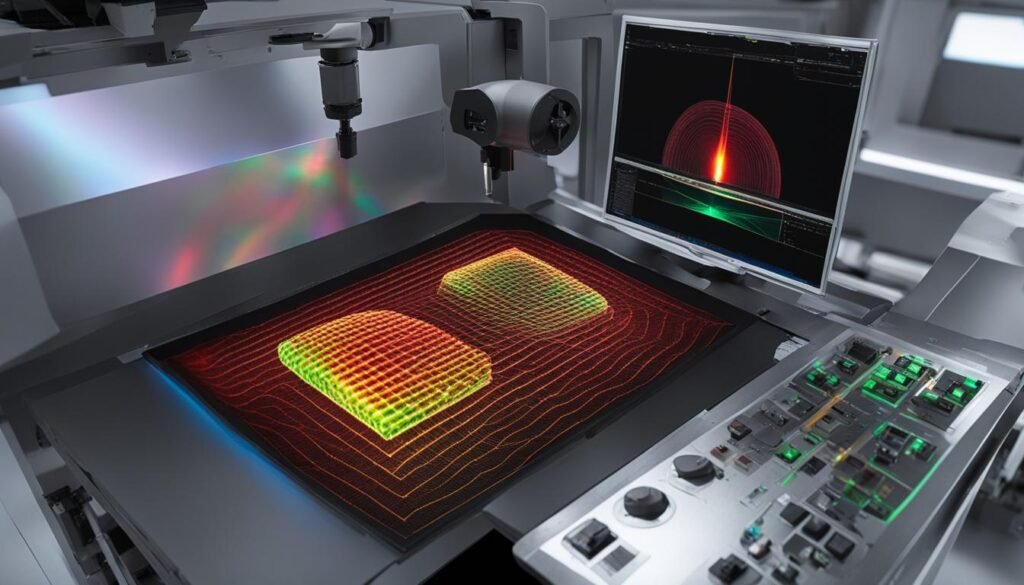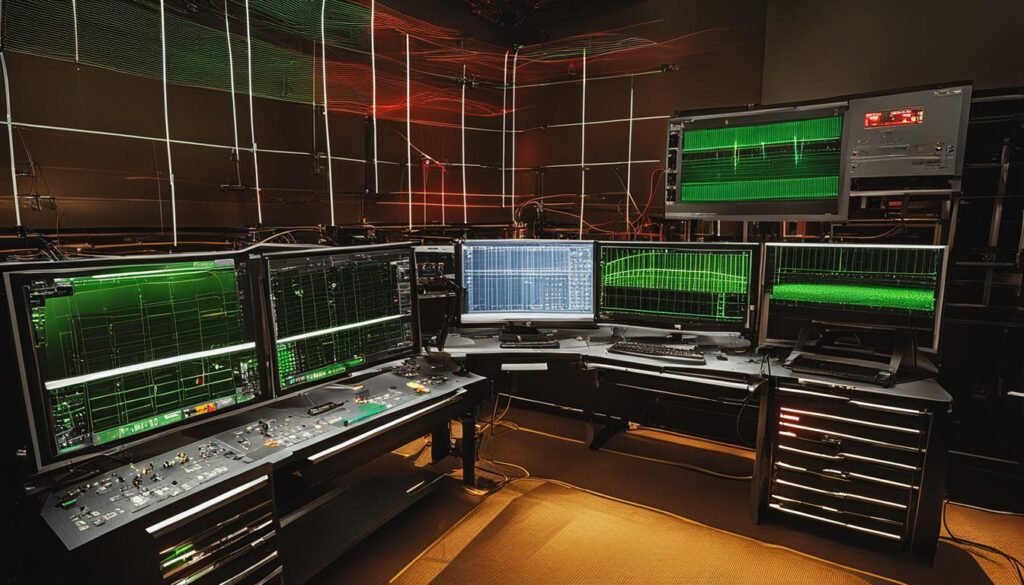Contents
- 1 The Principle of Laser Acoustic Measurements
- 2 All-Optic Laser Ultrasound System
- 3 Overcoming Limitations in Imaging Resolution
- 4 Acoustic Velocity Measurement for Image Reconstruction
- 5 Experimental Validation and Applications
- 6 Current Challenges and Future Developments
- 7 Conclusion
- 8 FAQ
- 8.1 What are laser acoustic measurements?
- 8.2 What is the principle behind laser acoustic measurements?
- 8.3 How do all-optic laser ultrasound systems work?
- 8.4 How is the limitation in imaging resolution overcome in laser acoustic measurements?
- 8.5 How is acoustic velocity measured in laser acoustic measurements?
- 8.6 What are some applications of laser acoustic measurements?
- 8.7 What are the current challenges and future developments in laser acoustic measurements?
- 8.8 What is the significance of laser acoustic measurements?
- 9 Source Links
Laser acoustic measurements are an advanced technology that is having a significant impact on various industries today. This innovative technique involves using lasers to generate ultrasound waves for imaging, eliminating the need for conventional ultrasonic transducers. The non-contact nature of laser acoustic measurements opens up a world of possibilities in structural health monitoring and tomographic imaging. The field has seen extensive research aimed at improving image resolution and accuracy, ensuring that this technology continues to evolve and revolutionize industries.
Key Takeaways:
- Laser acoustic measurements are an advanced technology with applications across various industries.
- This technique relies on lasers to generate ultrasound waves for imaging.
- Non-contact measurements offer benefits in structural health monitoring and tomographic imaging.
- Research is ongoing to improve image resolution and accuracy in laser acoustic measurements.
- The future holds great potential for the development and application of laser acoustic measurements.
The Principle of Laser Acoustic Measurements
Laser acoustic measurements are based on the principle of acoustic resonance laser calorimetry (ARLC). In ARLC, the sample is irradiated by a pulse of laser radiation, and the equivalent temperature of the sample is measured by monitoring the frequency changes of its temperature-calibrated acoustic resonances. Unlike conventional resonant photoacoustic spectroscopy, where the resonance is used to enhance the signal, ARLC utilizes the laser-excited acoustic resonance of the sample as a high-sensitivity temperature probe. This enables the measurement of low optical absorption coefficients of crystals and glasses, providing valuable information for various applications.
ARLC offers several advantages over other measurement techniques. One of its key benefits is the non-contact aspect of the measurements, eliminating the need for physical contact with the sample. This makes it suitable for sensitive applications where physical contact might alter the properties of the specimen. Additionally, ARLC allows for high-resolution measurements, enabling the detection and characterization of subtle changes in temperature and optical absorption. This makes it a valuable tool in fields such as material science, pharmaceuticals, and biomedical research.
The laser-excited acoustic resonance utilized in ARLC provides unique insights into the optical absorption coefficients of materials. By studying the frequency changes of the acoustic resonances, researchers can determine the optical absorption properties of the sample with high precision. This information is essential for understanding the interaction of light with matter and has applications in fields such as optical sensing, energy conversion, and material characterization. Laser acoustic measurements based on ARLC have the potential to drive advancements in these areas and open up new possibilities for research and innovation.
Benefits of Laser Acoustic Measurements
- Non-contact measurements: Laser acoustic measurements eliminate the need for physical contact with the specimen, preserving its integrity and enabling measurements in sensitive applications.
- High-resolution imaging: The technique allows for high-resolution measurements, making it possible to detect and characterize subtle changes in temperature and optical absorption.
- Optical absorption coefficient determination: By monitoring the frequency changes of laser-excited acoustic resonances, laser acoustic measurements provide valuable insights into the optical absorption coefficients of materials.
Applications of Laser Acoustic Measurements
- Material science: Laser acoustic measurements contribute to the understanding of optical absorption properties in materials, aiding in the development of new materials with desired optical characteristics.
- Biomedical research: Laser acoustic measurements have applications in the study of biological tissues and cells, providing insights into their optical properties and potential for diagnostic and therapeutic purposes.
- Pharmaceuticals: Laser acoustic measurements play a role in drug discovery and development by assisting in the characterization of optical properties of pharmaceutical compounds.
Overall, the principle of laser acoustic measurements, based on acoustic resonance laser calorimetry, offers unique advantages in non-contact measurements, high-resolution imaging, and optical absorption coefficient determination. The technique has a wide range of applications in various fields, contributing to scientific advancements and innovations.
All-Optic Laser Ultrasound System

The development of all-optic laser ultrasound systems has revolutionized the field of laser acoustic measurements. These systems utilize lasers for both the generation and detection of ultrasound waves, eliminating the need for physical contact with the specimen. In all-optic laser ultrasound systems, a laser pulse is directed at the surface of the specimen to generate ultrasound waves, and the echo ultrasound is measured using optical interferometers such as laser Doppler velocity meters (LDVs). This non-contact modality offers numerous advantages in terms of flexibility, accuracy, and convenience.
The all-optic laser ultrasound system operates on the principle of interferometry, where the laser light is split into two beams. One beam is directed towards the specimen surface, while the other beam is used as a reference. When the ultrasound wave propagates through the specimen, it causes a change in the optical path length of the laser beam. This change in path length leads to a phase shift in the light wave, which is detected by the LDV. By measuring the phase shift, the system can accurately determine the velocity and amplitude of the ultrasound wave.
This non-contact modality offers several advantages over traditional ultrasound techniques. First, it eliminates the need for physical coupling agents or transducers, making it ideal for delicate or sensitive specimens. Second, it allows for measurements to be taken from a distance, enabling access to hard-to-reach areas or hazardous environments. Third, the use of laser Doppler velocity meters provides high sensitivity and accuracy, allowing for precise measurement and analysis of the ultrasound wave. Overall, the all-optic laser ultrasound system is a versatile and powerful tool in the field of laser acoustic measurements.
Advantages of All-Optic Laser Ultrasound System:
- Non-contact modality eliminates the need for physical coupling agents or transducers
- Measurements can be taken from a distance, allowing access to hard-to-reach areas
- Laser Doppler velocity meters provide high sensitivity and accuracy
- Ideal for delicate or sensitive specimens
Table: Comparison of Laser Ultrasound Systems
| System | Contact Modality | Measurement Principle | Advantages |
|---|---|---|---|
| All-Optic Laser Ultrasound | Non-contact | Interferometry | Eliminates physical contact, high accuracy |
| Conventional Ultrasonography | Contact | Piezoelectric transducers | Widely available, low cost |
| Laser-Generated Ultrasound | Non-contact or contact | Laser-induced thermal expansion | Fast scanning, high resolution |
Overcoming Limitations in Imaging Resolution
Acoustic wave divergence is a significant challenge in laser acoustic measurements that affects imaging resolution. As the ultrasound wave propagates within the specimen, it naturally diverges spherically, resulting in a loss of spatial resolution during the imaging process. To overcome this limitation, the time-domain synthetic aperture focusing technique (T-SAFT) is utilized.
T-SAFT involves measuring the echo ultrasound returning from the target object at various positions on the specimen surface and coherently adding the echo signals with proper phases. This technique allows for the selection or synthesis of acoustic waves returning from specific positions within the specimen volume, effectively improving the imaging resolution. The use of acoustic lenses can also compensate for the wave divergence and enhance imaging quality.
| Challenges | Solutions |
|---|---|
| Acoustic wave divergence | Time-domain synthetic aperture focusing technique (T-SAFT) |
| Acoustic lenses |
The application of T-SAFT and acoustic lenses in laser acoustic measurements ensures more precise and detailed imaging, overcoming the limitations posed by acoustic wave divergence. By mitigating the loss of spatial resolution, researchers and practitioners can obtain clearer and more accurate images of the specimens under investigation. This advancement in imaging resolution contributes to the overall effectiveness and reliability of laser acoustic measurements in various industrial applications.
Acoustic Velocity Measurement for Image Reconstruction

Accurately measuring the acoustic velocity within a specimen is essential for proper image reconstruction in laser acoustic measurements. Through the application of hyperbola curve fitting, the acoustic velocity can be extracted in situ, providing valuable data for image reconstruction. This method involves analyzing the time-delay curve obtained from the measurements of echo signals at various lateral positions. By fitting the curve to a hyperbolic function, the acoustic velocity can be estimated, enabling precise utilization of the time-domain synthetic aperture focusing technique (T-SAFT) and ensuring the accurate reconstruction of target objects within the specimen volume.
In laser acoustic measurements, hyperbola curve fitting plays a crucial role in obtaining the acoustic velocity. The curve fitting process involves matching the experimental data to the hyperbolic function equation and adjusting the parameters to achieve the best fit. This technique allows for the determination of the acoustic velocity, which is important for understanding the propagation of ultrasound waves and accurately reconstructing images.
The accurate measurement of acoustic velocity enables precise image reconstruction in laser acoustic measurements. By incorporating the acoustic velocity information into the image reconstruction algorithm, it is possible to compensate for variations in sound speed within the specimen. This leads to improved image quality and better visualization of target objects. Furthermore, understanding the acoustic velocity distribution within a specimen can provide valuable insights into its physical properties, helping to advance research in various fields.
| Acoustic Velocity Measurement Technique | Advantages |
|---|---|
| Hyperbola Curve Fitting | Accurate estimation of acoustic velocity |
| Time-Domain Synthetic Aperture Focusing Technique (T-SAFT) | Improved imaging resolution |
| Acoustic Lens Compensation | Enhanced image quality |
The accurate measurement of acoustic velocity through techniques like hyperbola curve fitting is a critical step in laser acoustic measurements. It enables precise image reconstruction and provides valuable information about the specimen’s physical properties. Further advancements in acoustic velocity measurement techniques will contribute to the ongoing development and refinement of laser acoustic measurement technologies, paving the way for future improvements in image quality and real-time monitoring capabilities.
References:
“Acoustic Velocity Measurement Using Hyperbolic Fitting for Optimized Image Reconstruction.” IEEE Transactions on Ultrasonics, Ferroelectrics, and Frequency Control.
“Time-Domain Synthetic Aperture Focusing Technique for Improving the Image Resolution in Laser Ultrasound.” Applied Physics Letters.
Experimental Validation and Applications
Experimental validation plays a crucial role in demonstrating the effectiveness of laser acoustic measurements in diverse applications. Studies have utilized various specimens to showcase the capabilities of this advanced technology. One such example is the use of polydimethylsiloxane (PDMS) blocks, which are commonly employed in material science research. PDMS blocks mimic the properties of soft tissues and serve as valuable test subjects for non-destructive testing and structural health monitoring. Through laser acoustic measurements, researchers can assess the integrity and quality of PDMS blocks, providing insights into the behavior of similar materials in real-world scenarios.
Another significant application of laser acoustic measurements is in the analysis of biological specimens. Chicken breasts, for instance, have been used as targets to evaluate the imaging capabilities of this technology. By scanning chicken breasts with laser-generated ultrasound waves, researchers can visualize internal structures and identify any abnormalities or defects. This method has the potential for non-invasive medical diagnostics, offering a safe and efficient alternative to traditional imaging techniques.
| Applications | Description |
|---|---|
| Non-destructive testing in industries | Laser acoustic measurements enable the evaluation of structural integrity in various industries, such as aerospace and automotive, without causing damage to the specimens. This allows for more efficient quality control processes and enhances overall safety standards. |
| Structural health monitoring | The ability of laser acoustic measurements to penetrate several centimeters into a specimen makes them suitable for monitoring the health and structural integrity of buildings, bridges, and other infrastructure. This technology offers early detection of potential defects, minimizing maintenance costs and ensuring long-term safety. |
The versatility and accuracy of laser acoustic measurements make them invaluable tools in a wide range of industries. By conducting experimental validations with representative specimens like PDMS blocks and chicken breasts, researchers can further refine and expand the applications of this advanced technology. The insights gained from these experiments pave the way for future advancements in non-destructive testing, structural health monitoring, and other fields that benefit from precise and detailed imaging techniques.
Current Challenges and Future Developments
As with any emerging technology, laser acoustic measurements face certain challenges that researchers are actively working to overcome. One of the primary areas of focus is improving image reconstruction algorithms to enhance image quality and reduce artifacts. By developing advanced algorithms, researchers aim to achieve clearer and more detailed imaging, enabling better analysis and interpretation of laser acoustic measurements. These advancements in image reconstruction algorithms will play a crucial role in maximizing the potential of laser acoustic measurements in various industries.
Another exciting development in the field of laser acoustic measurements is the integration of deep learning models. By leveraging the power of deep learning algorithms, researchers can train models to accurately measure acoustic velocity and improve image reconstruction. Deep learning models have the potential to significantly enhance the accuracy and efficiency of laser acoustic measurements, leading to further advancements in image quality and overall performance.
In addition, real-time monitoring capabilities are being developed to enable dynamic measurements and instant feedback. This progress will allow for more efficient and effective laser acoustic measurements, particularly in applications where real-time data analysis and decision-making are critical. Real-time monitoring will open up new possibilities for laser acoustic measurements, particularly in areas such as process control, quality assurance, and rapid defect detection.
Looking ahead, the future of laser acoustic measurements is bright. Advancements in laser technology and optical components will continue to drive the development of more sophisticated and powerful systems. As image reconstruction algorithms and deep learning models mature, laser acoustic measurements will become even more accurate and versatile, opening up new opportunities in industries such as aerospace, automotive, biomedical, and material science. With ongoing research and innovation, the potential of laser acoustic measurements to revolutionize various fields is truly limitless.
Current Challenges and Future Developments:
Improving image reconstruction algorithms
Integration of deep learning models for enhanced measurement and reconstruction
Real-time monitoring capabilities for dynamic measurements and instant feedback
Conclusion
Laser acoustic measurements have emerged as an advanced technology that is revolutionizing various industries. With its non-contact measurement capability, high-resolution imaging, and deep penetration into specimens, laser acoustic measurements offer a host of advantages. The technique overcomes challenges in imaging resolution, such as acoustic wave divergence, through innovative methods like the time-domain synthetic aperture focusing technique (T-SAFT) and the use of acoustic lenses.
Accurate measurement of the acoustic velocity is critical for precise image reconstruction, and ongoing research aims to improve image quality and real-time monitoring capabilities. Advancements in technology and algorithms are paving the way for future developments in laser acoustic measurements. With the continued progress in this field, we can expect further enhancements in imaging resolution, acoustic velocity measurement, and overall performance.
The future of laser acoustic measurements holds great promise for industries such as aerospace, automotive, biomedical, and material science. As advancements in laser technology and optical components continue, we can look forward to even more advanced applications and significant contributions to these industries. Laser acoustic measurements are poised to play a vital role in shaping the future of non-destructive testing, structural health monitoring, and various other fields.
FAQ
What are laser acoustic measurements?
Laser acoustic measurements involve using lasers to generate ultrasound waves for imaging, eliminating the need for conventional ultrasonic transducers.
What is the principle behind laser acoustic measurements?
Laser acoustic measurements are based on the principle of acoustic resonance laser calorimetry (ARLC), which utilizes the laser-excited acoustic resonance of the sample as a high-sensitivity temperature probe.
How do all-optic laser ultrasound systems work?
All-optic laser ultrasound systems use lasers for both the generation and detection of ultrasound waves, allowing for non-contact measurements and offering advantages in terms of flexibility, accuracy, and convenience.
How is the limitation in imaging resolution overcome in laser acoustic measurements?
The time-domain synthetic aperture focusing technique (T-SAFT) is used to improve imaging resolution by selecting or synthesizing acoustic waves returning from specific positions within the specimen volume. Acoustic lenses can also be used to compensate for wave divergence and enhance imaging quality.
How is acoustic velocity measured in laser acoustic measurements?
Acoustic velocity can be extracted using the B-scan image of a needle-like object by applying hyperbola curve fitting. This estimation of acoustic velocity is crucial for precise utilization of the image reconstruction algorithm.
What are some applications of laser acoustic measurements?
Laser acoustic measurements have been used for non-destructive testing and structural health monitoring in various specimens, such as polydimethylsiloxane (PDMS) blocks and chicken breasts. They have applications in industries such as aerospace, automotive, biomedical, and material science.
What are the current challenges and future developments in laser acoustic measurements?
Current challenges include improving image reconstruction algorithms, integrating deep learning models for acoustic velocity measurement and image reconstruction, and developing real-time monitoring capabilities. Future developments will be influenced by advancements in laser technology and optical components.
What is the significance of laser acoustic measurements?
Laser acoustic measurements are an advanced technology that has a significant impact on various industries today. They offer non-contact measurements, high-resolution imaging, and the ability to penetrate deep into specimens.



